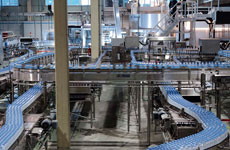
Sidel, a French specialist for PET liquid packaging solutions, is bringing the benefits of new technology to existing equipment owned by beverage producers around the world with its new Line Improvement services.
Part of the company’s recently announced Sidel Services business unit, the Line Improvement team improves existing lines using advanced line analysis tools and methodologies, a range of new innovations and technologies that are easily retrofitted and engineering experts with years of industry experience.
The team’s solutions can be applied to all Sidel PET complete lines and standalone blowers, fillers and labellers, regardless of configuration or line layout formats. They also work for all beverage products including water, carbonated soft drinks, liquid dairy products, juices, nectars, soft drinks, isotonics, teas and beer
According to Sidel, proof of the positive result for this effort is how a Coca-Cola bottler in the US achieved reductions in blowing pressure of up to 50%; while another Coca-Cola bottler in the UAE reduced energy by 20%. PepsiCo in Germany achieved a similar energy saving of 19%; Nestlé Waters achieved a productivity boost of 15% in France; and Mineral Quantum in Romania achieved savings of 45%.
Dag Gronevik, Vice President of Sidel Services, explained that older production equipment to continue to deliver efficiently with a reduced total cost of ownership is a goal shared by many beverage producers around the world; what comes with this goal is a desire to avoid investing in a new line or equipment, and instead getting more from existing production setups.
The reasons may vary in each case, from capital expenditure constraints, economic volatility, a need to invest elsewhere, or regulatory considerations. Yet there remains the need to ensure existing installed lines remain efficient and drive down costs, he said, adding that Sidel’s Line Improvement services can help expand the lifecycle of a line by foreseeing issues in advance, improving efficiency, and implementing the latest available technologies.
Examples of new technologies for older blowers include speed-up kits for faster output rates, eco-solutions for less electricity usage, stronger spindle chains for a longer life, and air-recovery kits for less air consumption. For fillers, examples include stronger valves for longer life, ultra-sonic functionality for less foaming, and product recovery kits for less liquid wastage. For labellers, there are label detectors for less jamming, quick changeover kits for reduced changeover times, label reduction kits for less material costs, and automatic splicers for increased daily production.
(PRA)






















